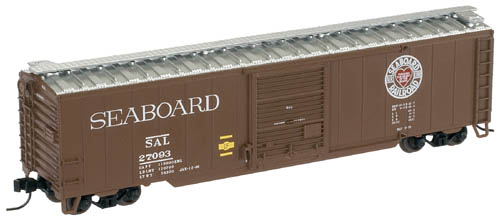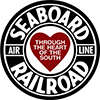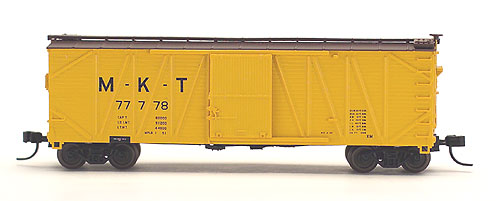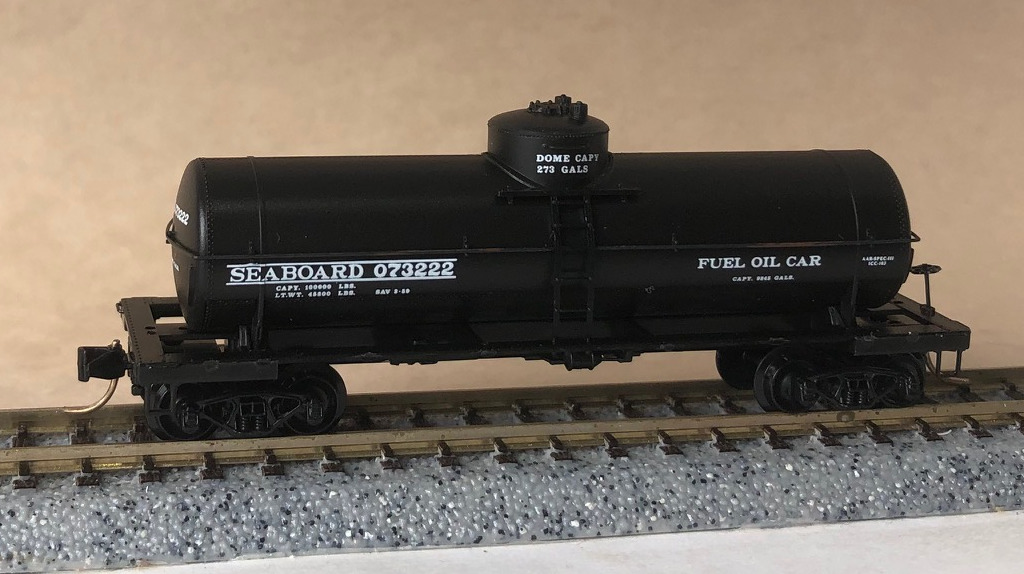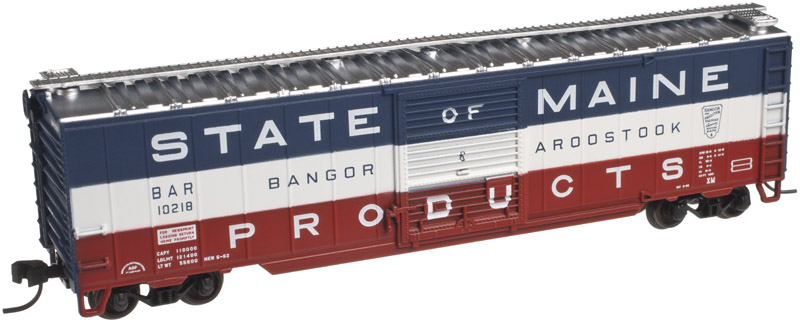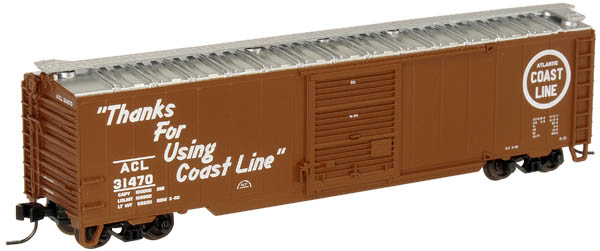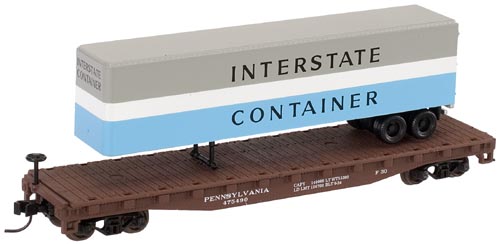Model Information: Atlas first announced this model in December of 2007 and delivered it in June of 2008. This model seemed to have been specifically developed as a budget model. It was introduced as part of the Trainman line from day 1. Most other Trainman models are older toolings that were 'downgraded' to Trainman due to age. Typically Trainman models have less detail and are thus easier to manufacture. When compared with other models being rolled out during that time, this this tooling was definitely a 2nd-class boxcar. We presume that it was specifically designed to be manufactured at a much lower price point than other cars such as the redesigned PS-1 boxcar also from Atlas which came out around the same time.
Prototype History: While the 40-foot boxcar was a standard design, and it did come in different setups depending on the type of freight being transported, it was not large enough for efficient mass commodity transportation. The 50-foot boxcar made its first appearance in the 1930s and steadily grew in popularity over the years, which further improved redundancies by allowing for even more space within a given car. Today, the 50-footer remains the common boxcar size. After the second world war ended, and steel became once again readily available, steel became the go-to choice for construction of boxcars. Pullman Standard and ACF were some of the most prolific builders of these cars.
These cars came in many variations. For instance, double-doors became practical for large/wide loads, end-doors useful for very large lading such as automobiles, and interior tie-down equipment was helpful in keeping sensitive products from being damaged in-transit. In 1954 the Santa Fe developed its "Shock Control" (and later "Super Shock Control") technology for new boxcars with upgraded suspension systems to further improve the ride-quality and reduce the chance of damaging freight.
In the 1960s, the flush, "plug" style sliding door was introduced as an option that provides a larger door to ease loading and unloading of certain commodities. The tight-fitting doors are better insulated and allow a car's interior to be maintained at a more even temperature.
These cars came in many variations. For instance, double-doors became practical for large/wide loads, end-doors useful for very large lading such as automobiles, and interior tie-down equipment was helpful in keeping sensitive products from being damaged in-transit. In 1954 the Santa Fe developed its "Shock Control" (and later "Super Shock Control") technology for new boxcars with upgraded suspension systems to further improve the ride-quality and reduce the chance of damaging freight.
In the 1960s, the flush, "plug" style sliding door was introduced as an option that provides a larger door to ease loading and unloading of certain commodities. The tight-fitting doors are better insulated and allow a car's interior to be maintained at a more even temperature.
Road Name History: The Seaboard Air Line Railroad (reporting mark SAL), which styled itself "The Route of Courteous Service," was an American railroad whose corporate existence extended from April 14, 1900 until July 1, 1967, when it merged with the Atlantic Coast Line Railroad, its longtime rival, to form the Seaboard Coast Line Railroad. The company was headquartered in Norfolk, Virginia, until 1958, when its main offices were relocated to Richmond, Virginia. The Seaboard Air Line Railway Building in Norfolk's historic Freemason District still stands and has been converted to luxury apartments.
At the end of 1925 SAL operated 3,929 miles of road, not including its flock of subsidiaries; at the end of 1960 it reported 4,135 miles. The main line ran from Richmond via Raleigh, North Carolina, Columbia, South Carolina, and Savannah, Georgia to Jacksonville, Florida, a major interchange point for passenger trains bringing travelers to the Sunshine State. From Jacksonville, Seaboard rails continued to Tampa, St. Petersburg, West Palm Beach and Miami.
Other important Seaboard routes included a line from Jacksonville via Tallahassee to a connection with the L&N at Chattahoochee, Florida, for through service to New Orleans; a line to Atlanta, Georgia, and Birmingham, Alabama, connecting with the main line at Hamlet, North Carolina; and a line from the main at Norlina, North Carolina, to Portsmouth, Virginia, the earliest route of what became the Seaboard.
In the first half of the 20th century Seaboard, along with its main competitors Atlantic Coast Line Railroad, Florida East Coast Railway and Southern Railway, contributed greatly to the economic development of the Southeastern United States, and particularly to that of Florida. Its brought vacationers to Florida from the Northeast and carried southern timber, minerals and produce, especially Florida citrus crops, to the northern states.
Wikipedia.
At the end of 1925 SAL operated 3,929 miles of road, not including its flock of subsidiaries; at the end of 1960 it reported 4,135 miles. The main line ran from Richmond via Raleigh, North Carolina, Columbia, South Carolina, and Savannah, Georgia to Jacksonville, Florida, a major interchange point for passenger trains bringing travelers to the Sunshine State. From Jacksonville, Seaboard rails continued to Tampa, St. Petersburg, West Palm Beach and Miami.
Other important Seaboard routes included a line from Jacksonville via Tallahassee to a connection with the L&N at Chattahoochee, Florida, for through service to New Orleans; a line to Atlanta, Georgia, and Birmingham, Alabama, connecting with the main line at Hamlet, North Carolina; and a line from the main at Norlina, North Carolina, to Portsmouth, Virginia, the earliest route of what became the Seaboard.
In the first half of the 20th century Seaboard, along with its main competitors Atlantic Coast Line Railroad, Florida East Coast Railway and Southern Railway, contributed greatly to the economic development of the Southeastern United States, and particularly to that of Florida. Its brought vacationers to Florida from the Northeast and carried southern timber, minerals and produce, especially Florida citrus crops, to the northern states.
Wikipedia.
Brand/Importer Information: In 1924 Stephan Schaffan, Sr. founded the Atlas Tool Company in Newark, New Jersey. In 1933 his son, Stephan Schaffan, Jr., came to work for his father at the age of sixteen. Steve Jr. built model airplanes as a hobby and frequented a local hobby shop. Being an enterprising young man, he would often ask the owner if there was anything he could do to earn some extra spending money. Tired of listening to his requests, the hobby-store owner threw some model railroad track parts his way and said, "Here, see if you can improve on this".
In those days, railroad modelers had to assemble and build everything from scratch. Steve Jr. created a "switch kit" which sold so well, that the entire family worked on them in the basement at night, while doing business as usual in the machine shop during the day.
Subsequently, Steve Jr. engineered the stapling of rail to fiber track, along with inventing the first practical rail joiner and pre-assembled turnouts and flexible track. All of these products, and more, helped to popularize model railroading and assisted in the creation of a mass-market hobby. The budding entrepreneur quickly outgrew the limitations of a basement and small garage operation. Realizing they could actually make a living selling track and related products, Steve and his father had the first factory built in Hillside, New Jersey at 413 Florence Avenue in 1947. On September 30, 1949, the Atlas Tool Company was officially incorporated as a New Jersey company.
In 1985, Steve was honored posthumously for his inventions by the Model Railroad Industry Association and was inducted into the Model Railroad Industry Hall of Fame in Baltimore, Maryland. In addition, Steve was nominated and entered into the National Model Railroad Association Pioneers of Model Railroading in 1995.
In the early 1990s, the Atlas Tool Company changed its name to Atlas Model Railroad Company, Inc.
In those days, railroad modelers had to assemble and build everything from scratch. Steve Jr. created a "switch kit" which sold so well, that the entire family worked on them in the basement at night, while doing business as usual in the machine shop during the day.
Subsequently, Steve Jr. engineered the stapling of rail to fiber track, along with inventing the first practical rail joiner and pre-assembled turnouts and flexible track. All of these products, and more, helped to popularize model railroading and assisted in the creation of a mass-market hobby. The budding entrepreneur quickly outgrew the limitations of a basement and small garage operation. Realizing they could actually make a living selling track and related products, Steve and his father had the first factory built in Hillside, New Jersey at 413 Florence Avenue in 1947. On September 30, 1949, the Atlas Tool Company was officially incorporated as a New Jersey company.
In 1985, Steve was honored posthumously for his inventions by the Model Railroad Industry Association and was inducted into the Model Railroad Industry Hall of Fame in Baltimore, Maryland. In addition, Steve was nominated and entered into the National Model Railroad Association Pioneers of Model Railroading in 1995.
In the early 1990s, the Atlas Tool Company changed its name to Atlas Model Railroad Company, Inc.
Item created by: Lethe on 2016-01-11 15:14:36. Last edited by CNW400 on 2020-06-02 09:48:56
If you see errors or missing data in this entry, please feel free to log in and edit it. Anyone with a Gmail account can log in instantly.
If you see errors or missing data in this entry, please feel free to log in and edit it. Anyone with a Gmail account can log in instantly.


